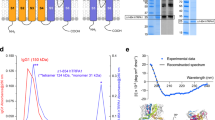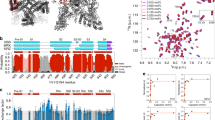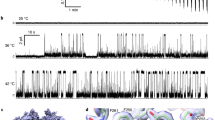Abstract
TRPM8, a member of the transient receptor potential (TRP) channel superfamily, is expressed in thermosensitive neurons, in which it functions as a cold and menthol sensor. TRPM8 and most other temperature-sensitive TRP channels (thermoTRPs) are voltage gated; temperature and ligands regulate channel opening by shifting the voltage dependence of activation. The mechanisms and structures underlying gating of thermoTRPs are currently poorly understood. Here we show that charge-neutralizing mutations in transmembrane segment 4 (S4) and the S4-S5 linker of human TRPM8 reduce the channel's gating charge, which indicates that this region is part of the voltage sensor. Mutagenesis-induced changes in voltage sensitivity translated into altered thermal sensitivity, thereby establishing the strict coupling between voltage and temperature sensing. Specific mutations in this region also affected menthol affinity, which indicates a direct interaction between menthol and the TRPM8 voltage sensor. Based on these findings, we present a Monod-Wyman-Changeux–type model explaining the combined effects of voltage, temperature and menthol on TRPM8 gating.
This is a preview of subscription content, access via your institution
Access options
Subscribe to this journal
Receive 12 print issues and online access
$259.00 per year
only $21.58 per issue
Buy this article
- Purchase on Springer Link
- Instant access to full article PDF
Prices may be subject to local taxes which are calculated during checkout






Similar content being viewed by others
References
Julius, D. & Basbaum, A.I. Molecular mechanisms of nociception. Nature 413, 203–210 (2001).
Moqrich, A. et al. Impaired thermosensation in mice lacking TRPV3, a heat and camphor sensor in the skin. Science 307, 1468–1472 (2005).
Clapham, D.E. TRP channels as cellular sensors. Nature 426, 517–524 (2003).
Patapoutian, A., Peier, A.M., Story, G.M. & Viswanath, V. ThermoTRP channels and beyond: mechanisms of temperature sensation. Nat. Rev. Neurosci. 4, 529–539 (2003).
Jordt, S.E., McKemy, D.D. & Julius, D. Lessons from peppers and peppermint: the molecular logic of thermosensation. Curr. Opin. Neurobiol. 13, 487–492 (2003).
Voets, T., Talavera, K., Owsianik, G. & Nilius, B. Sensing with TRP channels. Nat. Chem. Biol. 1, 85–92 (2005).
Talavera, K. et al. Heat activation of TRPM5 underlies thermal sensitivity of sweet taste. Nature 438, 1022–1025 (2005).
Voets, T. et al. The principle of temperature-dependent gating in cold- and heat-sensitive TRP channels. Nature 430, 748–754 (2004).
Chung, M.K., Guler, A.D. & Caterina, M.J. Biphasic currents evoked by chemical or thermal activation of the heat-gated ion channel, TRPV3. J. Biol. Chem. 280, 15928–15941 (2005).
Nilius, B. et al. The Ca2+-activated cation channel TRPM4 is regulated by phosphatidylinositol 4,5-biphosphate. EMBO J. 25, 467–478 (2006).
Xu, H., Blair, N.T. & Clapham, D.E. Camphor activates and strongly desensitizes the transient receptor potential vanilloid subtype 1 channel in a vanilloid-independent mechanism. J. Neurosci. 25, 8924–8937 (2005).
Rohacs, T., Lopes, C.M., Michailidis, I. & Logothetis, D.E. PI(4,5)P2 regulates the activation and desensitization of TRPM8 channels through the TRP domain. Nat. Neurosci. 8, 626–634 (2005).
Nilius, B. et al. Gating of TRP channels: a voltage connection? J. Physiol. (Lond.) 567, 35–44 (2005).
Peier, A.M. et al. A TRP channel that senses cold stimuli and menthol. Cell 108, 705–715 (2002).
McKemy, D.D., Neuhäusser, W.M. & Julius, D. Identification of a cold receptor reveals a general role for TRP channels in thermosensation. Nature 416, 52–58 (2002).
Montell, C. The TRP superfamily of cation channels. Sci. STKE 2005, re3 (2005).
Yellen, G. The voltage-gated potassium channels and their relatives. Nature 419, 35–42 (2002).
Bezanilla, F. Voltage-gated ion channels. IEEE Trans. Nanobioscience 4, 34–48 (2005).
Aggarwal, S.K. & MacKinnon, R. Contribution of the S4 segment to gating charge in the Shaker K+ channel. Neuron 16, 1169–1177 (1996).
Seoh, S.A., Sigg, D., Papazian, D.M. & Bezanilla, F. Voltage-sensing residues in the S2 and S4 segments of the Shaker K+ channel. Neuron 16, 1159–1167 (1996).
MacKinnon, R. Structural biology. Voltage sensor meets lipid membrane. Science 306, 1304–1305 (2004).
Long, S.B., Campbell, E.B. & MacKinnon, R. Voltage sensor of Kv1.2: structural basis of electromechanical coupling. Science 309, 903–908 (2005).
Long, S.B., Campbell, E.B. & MacKinnon, R. Crystal structure of a mammalian voltage-dependent Shaker family K+ channel. Science 309, 897–903 (2005).
Brauchi, S., Orio, P. & Latorre, R. Clues to understanding cold sensation: thermodynamics and electrophysiological analysis of the cold receptor TRPM8. Proc. Natl. Acad. Sci. USA 101, 15494–15499 (2004).
Correa, A.M., Bezanilla, F. & Latorre, R. Gating kinetics of batrachotoxin-modified Na+ channels in the squid giant axon. Voltage and temperature effects. Biophys. J. 61, 1332–1352 (1992).
Almers, W. Gating currents and charge movements in excitable membranes. Rev. Physiol. Biochem. Pharmacol. 82, 96–190 (1978).
Sigworth, F.J. Voltage gating of ion channels. Q. Rev. Biophys. 27, 1–40 (1994).
Wright, C.E., Bowen, W.P., Grattan, T.J. & Morice, A.H. Identification of the L-menthol binding site in guinea-pig lung membranes. Br. J. Pharmacol. 123, 481–486 (1998).
Bandell, M. et al. High-throughput random mutagenesis screen reveals TRPM8 residues specifically required for activation by menthol. Nat. Neurosci. 9, 493–500 (2006).
Togashi, K. et al. TRPM2 activation by cyclic ADP-ribose at body temperature is involved in insulin secretion. EMBO J. 25, 1804–1815 (2006).
Colquhoun, D. Binding, gating, affinity and efficacy: the interpretation of structure-activity relationships for agonists and of the effects of mutating receptors. Br. J. Pharmacol. 125, 924–947 (1998).
Hille, B. Ion Channels of Excitable Membranes (Sinauer Associates, Sunderland, Massachusetts, USA, 2001).
Lee, H., Iida, T., Mizuno, A., Suzuki, M. & Caterina, M.J. Altered thermal selection behavior in mice lacking transient receptor potential vanilloid 4. J. Neurosci. 25, 1304–1310 (2005).
Caterina, M.J. et al. Impaired nociception and pain sensation in mice lacking the capsaicin receptor. Science 288, 306–313 (2000).
Schoppa, N.E., McCormack, K., Tanouye, M.A. & Sigworth, F.J. The size of gating charge in wild-type and mutant Shaker potassium channels. Science 255, 1712–1715 (1992).
Islas, L.D. & Sigworth, F.J. Voltage sensitivity and gating charge in Shaker and Shab family potassium channels. J. Gen. Physiol. 114, 723–742 (1999).
Hirschberg, B., Rovner, A., Lieberman, M. & Patlak, J. Transfer of twelve charges is needed to open skeletal muscle Na+ channels. J. Gen. Physiol. 106, 1053–1068 (1995).
Noceti, F. et al. Effective gating charges per channel in voltage-dependent K+ and Ca2+ channels. J. Gen. Physiol. 108, 143–155 (1996).
Nilius, B. et al. Voltage dependence of the Ca2+-activated cation channel TRPM4. J. Biol. Chem. 278, 30813–30820 (2003).
Chuang, H.H., Neuhausser, W.M. & Julius, D. The super-cooling agent icilin reveals a mechanism of coincidence detection by a temperature-sensitive TRP channel. Neuron 43, 859–869 (2004).
Gavva, N.R. et al. Molecular determinants of vanilloid sensitivity in TRPV1. J. Biol. Chem. 279, 20283–20295 (2004).
Brauchi, S., Orta, G., Salazar, M., Rosenmann, E. & Latorre, R. A hot-sensing cold receptor: C-terminal domain determines thermosensation in transient receptor potential channels. J. Neurosci. 26, 4835–4840 (2006).
Rothberg, B.S. Allosteric modulation of ion channels: the case of maxi-K. Sci. STKE 2004, pe16 (2004).
Robinson, R.B. & Siegelbaum, S.A. Hyperpolarization-activated cation currents: from molecules to physiological function. Annu. Rev. Physiol. 65, 453–480 (2003).
Papazian, D.M. et al. Electrostatic interactions of S4 voltage sensor in Shaker K+ channel. Neuron 14, 1293–1301 (1995).
Sasaki, M., Takagi, M. & Okamura, Y. A voltage sensor-domain protein is a voltage-gated proton channel. Science 312, 589–592 (2006).
Ramsey, I.S., Moran, M.M., Chong, J.A. & Clapham, D.E. A voltage-gated proton-selective channel lacking the pore domain. Nature 440, 1213–1216 (2006).
Ho, S.N., Hunt, H.D., Horton, R.M., Pullen, J.K. & Pease, L.R. Site-directed mutagenesis by overlap extension using the polymerase chain reaction. Gene 77, 51–59 (1989).
Vriens, J. et al. Cell swelling, heat, and chemical agonists use distinct pathways for the activation of the cation channel TRPV4. Proc. Natl. Acad. Sci. USA 101, 396–401 (2004).
Acknowledgements
We thank G. Droogmans, F. Mahieu, J. Vriens, R. Vennekens and J. Prenen for helpful suggestions and criticisms, and A. Patapoutian and M. Bandell for the Y745H and L1009R mutants. This work was supported by grants from the Human Frontiers Science Program (RGP32/2004), the Belgian Federal Government (IUAP P5/05), the Research Foundation–Flanders (G.0136.00, G.0172.03 and G.0565.07) and the Research Council of the KU Leuven (GOA2004/07 and EF/95/010).
Author information
Authors and Affiliations
Contributions
T.V. designed, performed and analyzed the electrophysiological experiments. G.O. developed the radioligand binding assay and conducted the biochemical experiments and molecular modeling. A.J. designed and performed TRPM8 mutagenesis. T.V. and K.T. performed the mathematical modeling. T.V. wrote the manuscript; G.O., K.T. and B.N. edited the manuscript; and T.V. and B.N. supervised the project.
Corresponding author
Ethics declarations
Competing interests
The authors declare no competing financial interests.
Supplementary information
Supplementary Fig. 1
Examples of the method used to determine Popen. (PDF 131 kb)
Supplementary Fig. 2
Fits of two published models describing the temperature dependence of TRPM8 to experimental data. (PDF 119 kb)
Supplementary Fig. 3
[3H]menthol displacement experiments on nontransfected HEK 293 cells and on cells expressing TRPM2, WT TRPM8 and TRPM8 mutants. (PDF 83 kb)
Supplementary Fig. 4
Plasma membrane expression and current densities for different TRPM8-TRPM5 chimeras. (PDF 249 kb)
Supplementary Fig. 5
Additional predictions of the MWC model. (PDF 99 kb)
Supplementary Table 1
Parameters that describe the expression level, voltage dependence, temperature dependence and menthol sensitivity of WT and mutant TRPM8. (PDF 218 kb)
Supplementary Methods
Procedure for determination of activation curves, comparison of two models describing the temperature dependence of TRPM8, and mathematical description of the MWC and HH models. (PDF 264 kb)
Rights and permissions
About this article
Cite this article
Voets, T., Owsianik, G., Janssens, A. et al. TRPM8 voltage sensor mutants reveal a mechanism for integrating thermal and chemical stimuli. Nat Chem Biol 3, 174–182 (2007). https://doi.org/10.1038/nchembio862
Received:
Accepted:
Published:
Issue Date:
DOI: https://doi.org/10.1038/nchembio862
This article is cited by
-
Relation between flexibility and intrinsically disorder regions in thermosensitive TRP channels reveal allosteric effects
European Biophysics Journal (2024)
-
Targeting natural products against SARS-CoV-2
Environmental Science and Pollution Research (2022)
-
Structural basis for promiscuous action of monoterpenes on TRP channels
Communications Biology (2021)
-
Natural Bioactive Compounds as Potential Browning Agents in White Adipose Tissue
Pharmaceutical Research (2021)
-
Intracellular activation of full-length human TREK-1 channel by hypoxia, high lactate, and low pH denotes polymodal integration by ischemic factors
Pflügers Archiv - European Journal of Physiology (2021)



